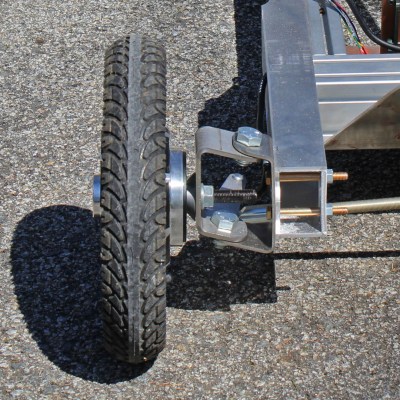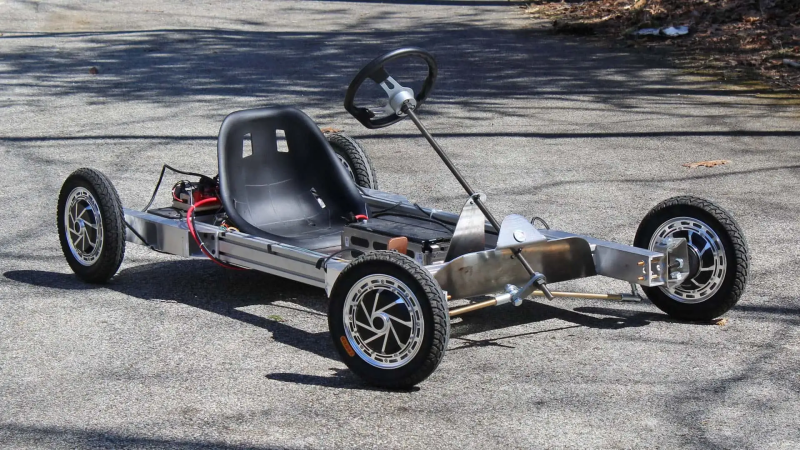[Peter Holderith] set out some time ago to build an electric go-kart. That by itself is not terribly unusual, but where his project diverts from the usual is in the fact that each of the four wheels has an integrated hub motor.

This kart project is a bit of a work in progress, with [Peter] previously building (then scrapping) a failed attempt at a cheap suspension system. But it’s completely operational with all four wheels able to deliver a monstrous amount of power despite being limited by the power supply (a battery pack salvaged from an Audi Q5 Hybrid).
The kart might not look it, but it weighs 177 pounds (80 kg) with the battery and motors accounting for nearly half of that. What is is like to drive? “Nothing short of thrilling,” says [Peter]. It’s got no suspension and is pretty bare bones, not to mention limited in power by the battery, but [Peter] finds it a satisfying drive that nevertheless delivers car-like cues in the driving experience. The build isn’t done, and [Peter] plans to see if more power is available by switching battery chemistries rather than add more battery weight.
Building and driving electric vehicles can be remarkably satisfying, and it’s an area in which hobbyists can meaningfully innovate. Self-balancing one-wheeled vehicles for example look like a ton of fun. Heck, researchers have discovered that even rats seem to enjoy driving just for the fun of it.
















My brain wants to play: A constraint mentioned in the linked article is that the battery cannot produce the 400 amps needed to max the quad wheel drive setup.
In 1974, Mother Earth News published a project from a guy who converted an Opel GT to a hybrid-electric vehicle. It ran off a 16 horsepower McCulloch motor that powered a generator that charged the batteries. When it needed passing power (up to about 75 miles per hour) the generator delivered directly to the electric motor.
Looking at this go-kart project, I see a prototype of a new version: Think how much less power is needed by in-hub motors instead of going though a drive train. A very small gas engine and a good generator could definitely provide the current needed to max out the motors. (I’d think about hacking my Honda 1001 to get this started.) How about a turbine to drive the generator so that (after the Zombie Apocalypse and collapse of Industry) the engine could burn anything?
Seems like all that would add a lot more weight than a better battery
Yeah, all the improvements would require more weight. For a go-kart, that might be excessive. However, for a transportation prototype it’s doable. The go-kart battery is only 30 lbs, but a long-range battery would have to be much more massive. Add another 25-30 lbs for engine/generator, and weight of fuel, and you easily tripled the weight, but the original MEN Opel project was rated at 75mpg, so a 10-gal. fuel tank could get you quite a long way.
We are obviously talking about a completely different project from a simple go-cart, though.
30lbs?? It’s charged with coal. I’ll race you. NY to LA. Let’s go.
I have wanted to see a turbine genset on an EV for decades, but they don’t really miniaturize well enough to come to market, it seems like. There have been a handful of companies trying it, but nothing promising enough to replace the more conventional motorcycle engine as an EV range-extender, like was used in the BMW i3 hybrid.
Indeed EV range extenders are ripe territory for alternative engine designs, since they only really need to run at constant speed/torque etc. Liquid piston, ball-piston, star-rotor, wave-disc, scuderi, steltzer, OPOC, cyclone motor, uttlin-kugelmotor, etc, etc.
Yeah, at smaller scales a piston, especially a big slow piston, is hard to beat. One way to give it a run for its money is to put a turbine in series with the piston, such as with a turbodiesel. Then you can have a decent turbine pressure ratio compounded with a decent piston compression ratio. Something related to that and the blowdown turbines like on Wright R-3350’s or the MGU-H e-turbo’s from F1 might be neat. With some heat recovery too I guess – if nothing else, and if we’re going for silly complexity, it could use waste heat for an absorption chiller cycle.
https://fusionflight.com/arc/
This guy has been doing interesting stuff with coffee can sized gas turbines for a while now. The price tag is just under $20k USD with a three month lead time on the build.
That said it can be carried with one hand maxes out at 8kW 200A 85VDC. It’ll run on diesel too, the only odd thing about it is that you have to mix the fuel at 5% lubricant regardless of the fuel type used. You’re not going to save on fuel consumption, its a turbine, but its hard to argue with the power to weight ratio. Unless I’ve misread the spec sheet an equivalent Cummins is over 400 lbs.
Math does not check out. He is talking about 20,000w, you are talking about 1,000 watts. 40v x 400A is Maybe change to a hybrid battery pack that can deliver more instant amps? Or add 50-100% battery pack.
I will assure you that you can’t put this power down. Better to start with a go-kart frame, add taller wheels and do RWD only. (Look to Formula SAE and see what they are doing to solve these problems). Also more than a quarter of the weight is in the wheels. This is Not Good™ for handling. I foresee going with a very small EV drivetrain and maybe a belt drive to a one way drive on the front axle like an AWD RC car might be the way to go. Use some tiny CV axles and try to get the unsprung mass lower.
Million ways to do this, and as this guy is learning, everything is a trade-off. I eagerly look forward to see what Gordon Murray will do for an EV/Hybrid. He is a whiz of an engineer with a good grasp of what works. Technically also a Hacker, as a broke young man living in England he created a mid-engine sports car out of a Mini Cooper and a common van V6. Built one for sale and a second for himself from the proceeds. That’s a great hack.
I wonder if unsprung weight is an issue here since there are no springs; the whole thing is unsprung.
Ugh. Unsprung weight. Even in a go-cart this doesn’t sound like a great idea.
Install a sprung seat from a modern tractor. Most tractors also have no sprung suspension.
Most people don’t want their race vehicles to handle like a tractor :-)
Well first, it depends on which tractor you’re looking at. :)
Most people on a go-kart don’t have lots of things, including sprung suspension. Go-karts meant for racing do things like making sure that the inner wheel always lifts on cornering so that you don’t need a differential and can just have a solid axle. Their steering and braking will also be questionable, they’ll often intentionally run their engines into valve float to get more speed out of a fixed sprocket ratio, and they’ll cut off anything that doesn’t seem obviously necessary to try and make things smaller and lighter. Relying on the flex of the frame and the deflection of the tires seems entirely in character. :P
Suspension? Just hang it an inch off the ground and take the bumps. It’ll be fine.
Not to mention the wheels are attached by single, hollow studs
I had missed the rats driving cars article.
Thanks for including the link!
Chibikart rides again!
Thats a thing i want to do one day, a project with high power electronics. For now the price of the gear is just too much for me. Nice job
What about a nitro RC car engine ,they seem stupidly quick now a days,,would that be of any use maybe to create a way off boost?
They might be quick when moving something less than 5kg. It’s not going to do much to something on the order of 100kg.
Looking forward to when the builder to soon decide that this is great platform to experiment with advance driving dynamics, perhaps thrust vectoring making this little kart into a hyper-kart. I think it will happen :) #kudos great build!
I attached a solar generator (which is basically a battery with an inverter) to my e scooter and connected the charging cable and plugged it into the inverter. It basically adds a constant charger to the battery and extends the range but when the battery is full as it usually is the power from the charger is used and increases the motors power a bit. The only drawback is the weight added is about 50lbs .
So my ebike conversion weighs 45 pounds top speed of 22 mph will go 30 miles on a charge with pedalling assistance, is street legal, is much safer to ride and I get lots of exercise but I do have to balance.
Those axle bolts aren’t long for the world. Metal fatigue is bitch. Needs more then tire sidewall for suspension.
Is spine wrecker. Builder may regret this project for _rest_of_life_. Not even padding in seat.
Also tire and wheel choice is extremely poor.
Those are bike tires, built to lean. It’s a gocart.
Use the big contact patch available. Also smaller wheel, taller sidewalls for some bump absorption.
Smaller motors on the front.
Install brakes, reactive braking is fine, needs backup.
Also NEEDS PULSEJETS.
Same as the last gocart.
Why aren’t there any shocks?
Add some super capacitors for boost..
FYI: The Samsung SDI lithium module used in this project is rated to output 335 amps for ten seconds at 50% SoC, between 25:40 degC ambient, with a 2% pulse repeat rate. Under this load, the under voltage cell threshold is 1.8 volts.